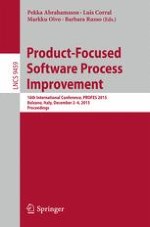This book constitutes the refereed proceedings of the 16th International Conference on Product-Focused Software Process Improvement, PROFES 2015, held in Bolzano, Italy, in December 2015.
The 18 revised full papers presented together with 10 short papers and 18 workshop papers were carefully reviewed and selected from 50 submissions. The papers are organized in topical sections on lessons learned from industry-research collaborations; instruments to improve the software development process; requirements, features, and release management; practices of modern development processes; human factors in modern software development; effort and size estimation validated by professionals; empirical generalization; software reliability and testing in industry; workshop on processes, methods and tools for engineering embedded systems; workshop on human factors in software development processes; and workshop on software startups: state of the art and state of the practice.
